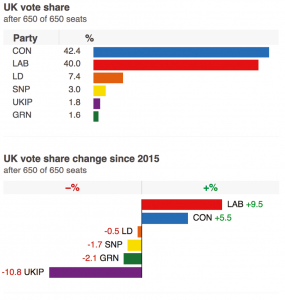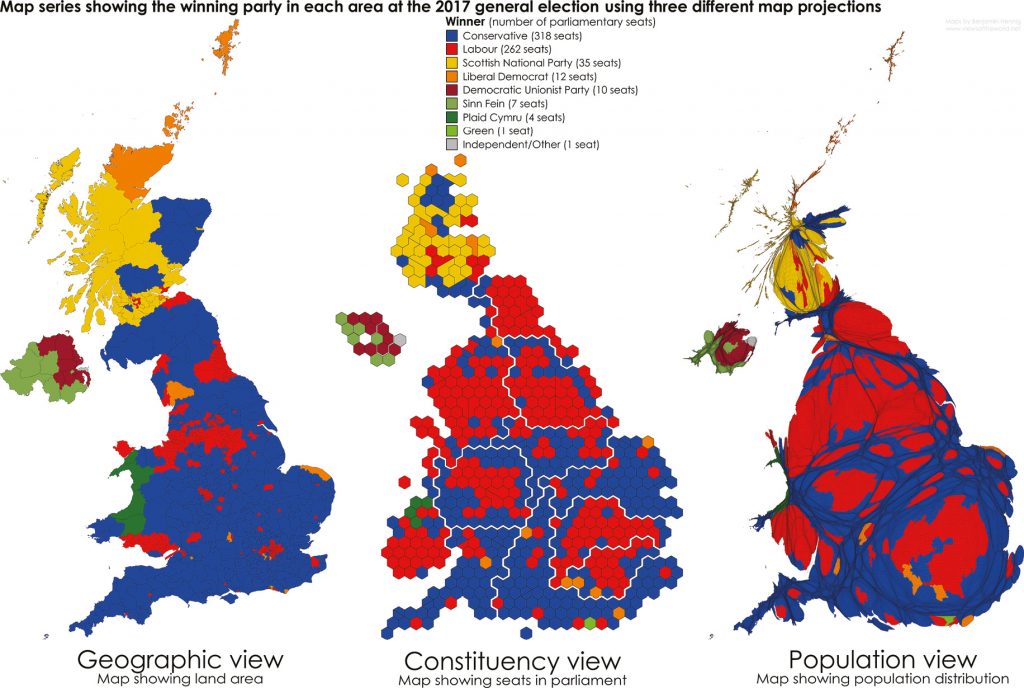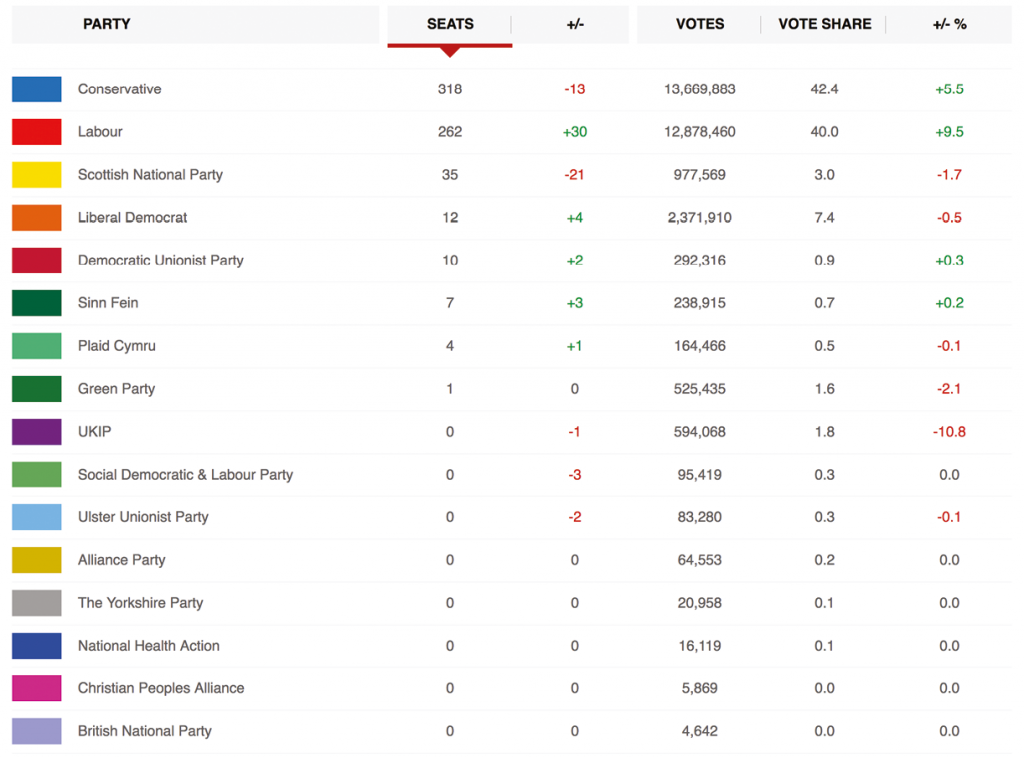
Associate Professor of Journalism and Communication at Bournemouth University
Email: ethorsen@bournemouth.ac.uk
Twitter: @einarthorsen

Associate Professor of Media and Communications at Bournemouth University
Email: JacksonD@bournemouth.ac.uk
Twitter: @dan_jackson9

Associate Professor of Political Communication at Bournemouth University
Email: dlilleker@bournemouth.ac.uk
Twitter: @DrDGL
“We want a strong and stable government, not a coalition of chaos, led by Jeremy Corbyn”. These words, uttered by Greg Knight – Conservative candidate for East Yorkshire – in the campaign’s most infamous campaign video, came to represent a microcosm of the 2017 UK General Election campaign. First, it put Theresa May front and centre of all Conservative campaign communications. Second, it contained the Conservative Party’s key election message – based on the belief that endlessly repeated slogans were the only way to cut through the increasingly chaotic and fragmented news cycle. And third, it was a terribly executed piece of political communication, which rather summed up the Tory campaign as a whole. By the end, ‘strong and stable’ was a thoroughly discredited slogan, as the Tories went on to develop their own ‘coalition of chaos’ with the Democratic Unionist Party.
 Things weren’t supposed to turn out like this. In early April 2017, the Conservatives were at least 20 points up in most polls, and the Prime Minister’s personal ratings soared above those of Jeremy Corbyn by at least 40 points. These were unprecedented numbers, and so with her opponents looking ripe for the taking, Theresa May took the opportunity to crush the Labour Party for a generation and secure her own mandate. With the might of the Conservative campaigning machine at her disposal and the partisan press firmly behind her, she was widely expected to deliver a landslide majority for her party.
Things weren’t supposed to turn out like this. In early April 2017, the Conservatives were at least 20 points up in most polls, and the Prime Minister’s personal ratings soared above those of Jeremy Corbyn by at least 40 points. These were unprecedented numbers, and so with her opponents looking ripe for the taking, Theresa May took the opportunity to crush the Labour Party for a generation and secure her own mandate. With the might of the Conservative campaigning machine at her disposal and the partisan press firmly behind her, she was widely expected to deliver a landslide majority for her party.
But we live in unconventional times, where the rules of the game are being perpetually rewritten. Even in the context of the election of Trump the Brexit vote, the General Election of 2017 will go down as one of most extraordinary campaigns of recent times.
This was also an election campaign that was twice suspended: firstly, after the Manchester Arena bombing on 22nd May that killed 23 and injured 119 people; and secondly, after the London terrorist attack 3rd June that left 8 dead and 48 wounded. Both events had a dramatic impact on the ‘mood of the nation’, and of course influenced the agenda of the campaign with regards to security and policing.
This unique election has raised countless questions and talking points, which pollsters, journalists, academics, commentators and politicians alike are all busy analysing. This project, and report that follows, is our contribution to our shared purpose of making sense of the 2017 election. To do this, we have again turned to leading academics in the UK and beyond – a mix of world-leading experts and early career researchers – to offer their reflections, analysis and early research findings on the election campaign.
After Section 1 outlines the context in which this election was called, we begin to unpack voting patterns in Section 2 and their possible explanations. After over a decade of rising multi-party politics, 2017 saw the return of two-party dominance, with the Conservatives and Labour gaining 82% of vote share and 89% of seats. The real story of voters in 2017 was turnout (at nearly 69% the highest since 1997) despite an electorate seemingly jaded from repeated votes, and the mass mobilization and engagement of younger voters (particularly by the Labour Party). Here, the unprecedented generational divide between young and old is one of the key stories to emerge.
In both the 2015 General Election and 2016 EU referendum campaigns, the (mostly right-wing) British press was credited with a crucial influence on the outcomes, and in 2017 they again followed their usual script. Abuse was continually directed at the Labour party and its supposedly shambolic leader, amid a constant diet of misinformation and spin. But this time – no matter how bluntly partisan – the press had limited effect. Section 3 examines this phenomenon in detail, pointing towards the counter-balancing role of social media (Section 5), which for the first time, might have played a decisive role in a UK election campaign. The power of television also endures. As Jeremy Corbyn relished being in the spotlight, Theresa May performed badly when unscripted and dodged debating with opponents. Section 4 thus examines the party and campaign dynamics that might explain this most unexpected of results exploring the reasons for the Tory campaign faltering from the start and for Labour to be resurgent.
With an increasing dis-United Kingdom under the shadow of Brexit we also examine the dynamics across the nations of Britain. There are two important stories that emerged from the nations in 2017 which are examined in Section 6. The first is the erosion of the SNP share of seats (from the historic high in 2015), and the second is in Northern Ireland, where the DUP not only gained seats but became kingmakers in a hung parliament. Section 7 then moves to focus on Brexit, the pretext for the election that largely became a non-issue, hence it is important to gauge perspectives of the contest from key European countries.
Finally, in Section 8 we capture perhaps one of the most interesting dynamics of the election. The interplay between politics and popular culture and the role personality played in the outcome.
Published within ten days of the result, these contributions are short and accessible. Authors provide authoritative analysis of the campaign, including research findings or new theoretical insights; to bring readers original ways of understanding the campaign. Contributions also bring a rich range of disciplinary influences, from political science to cultural studies, journalism studies to psychology. We hope this makes for a vibrant, informative and engaging read.


